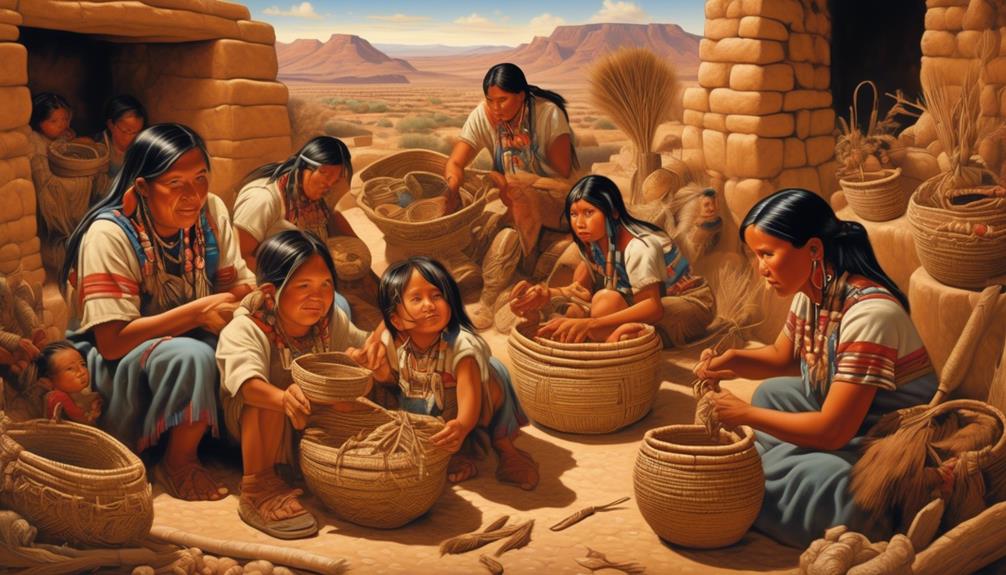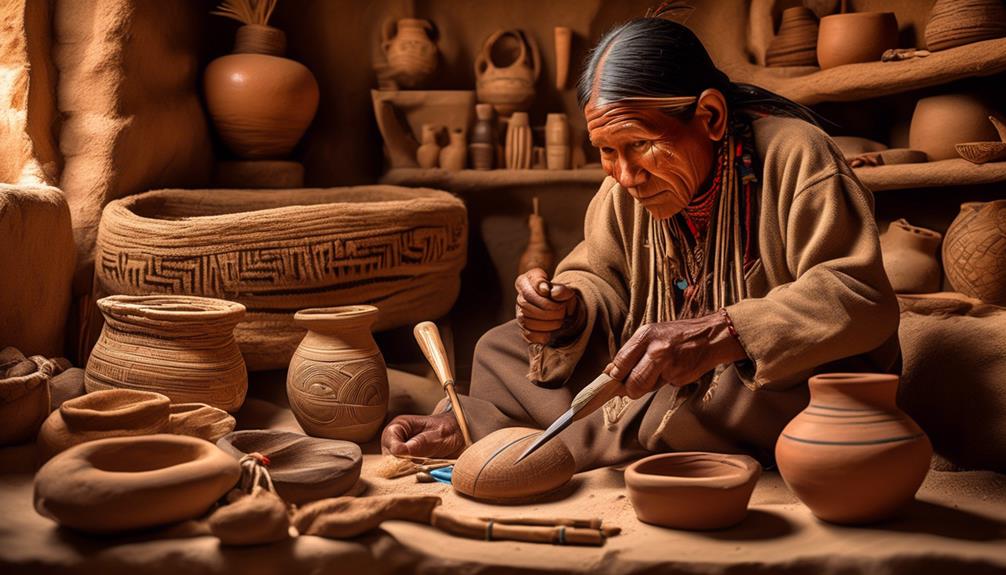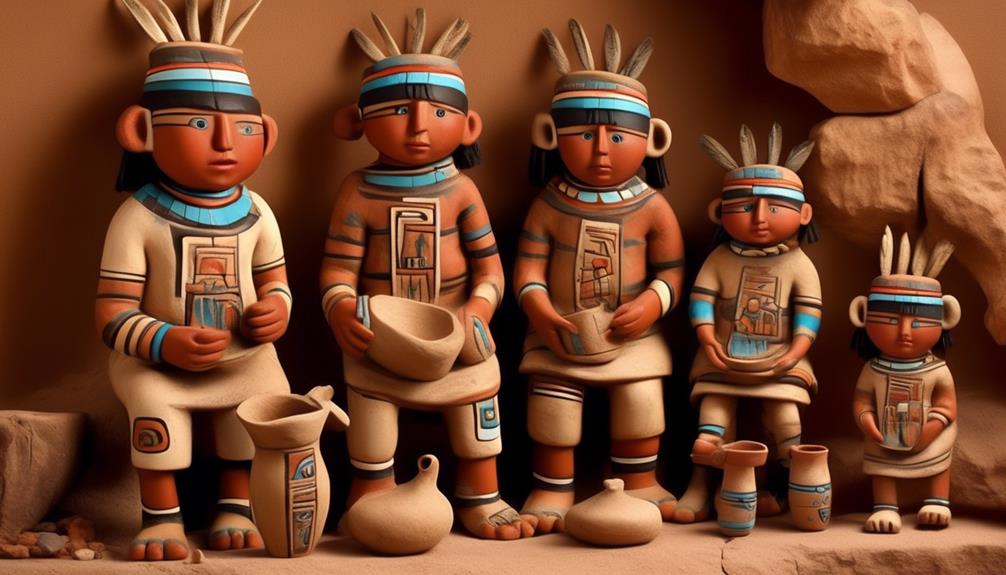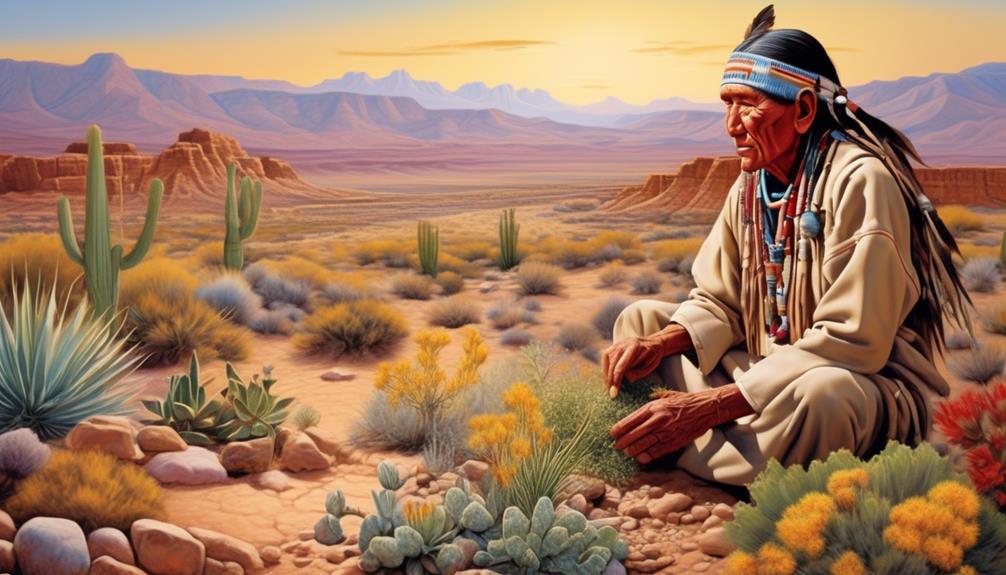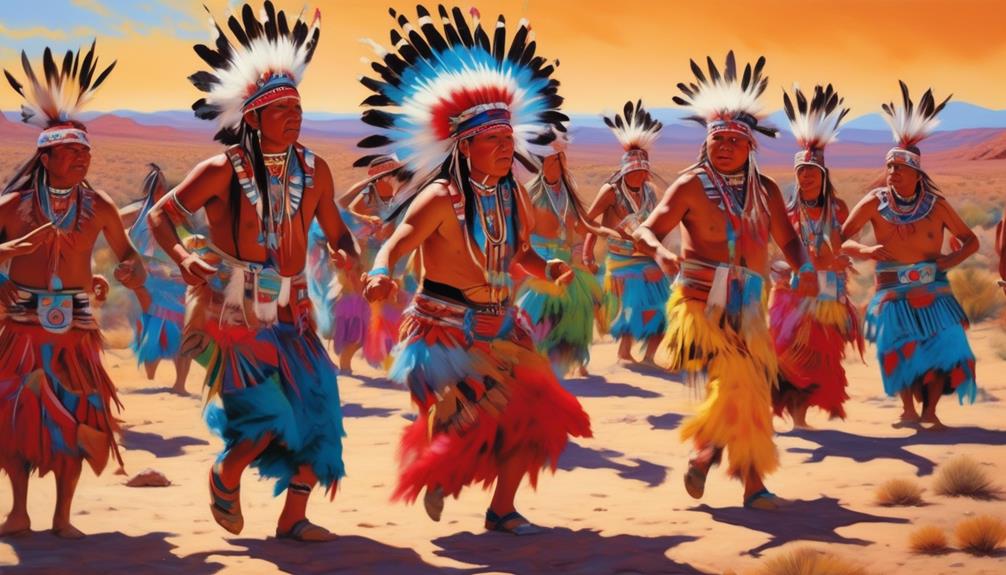While standing on the red soil of the Hopi lands, it’s hard not to be fascinated by the complex network of duties and roles that shaped the lives of both men and women in this historic tribe.
From the rhythmic pounding of corn by the women to the strong, purposeful strides of the men as they prepared for the sacred ceremonies, the Hopi society was a mosaic of tradition and duty.
But how did these roles shape the everyday life of the tribe? And what impact did they have on the rich tapestry of Hopi culture and community?
Key Takeaways
- Men in the Hopi Tribe have responsibilities in agricultural stewardship, ceremonial participation, and community construction.
- Women in the Hopi Tribe actively participate in agricultural work, pottery-making, and engage in community leadership and decision-making.
- Gender roles in Hopi ceremonies reflect balance and interconnectedness, with women having essential roles in preparation and performance.
- Gender expectations shape roles and responsibilities in Hopi society, influencing the division of labor, distribution of responsibilities, and social dynamics within the tribe.
Traditional Gender Roles in Hopi Society
In Hopi society, traditional gender roles are deeply rooted in the cultural and spiritual practices of the tribe, guiding the responsibilities and expectations for men and women. Gender division is a fundamental aspect of Hopi culture, where men and women have distinct roles that contribute to the functioning of the community.
The social hierarchy within the tribe delineates specific duties for each gender, with men often responsible for activities such as farming, hunting, and building, while women are typically involved in tasks related to weaving, pottery, and the general welfare of the family. This division of labor isn't based on a hierarchy of value but rather on complementarity, where both men and women are seen as essential components of a cohesive and balanced society.
Moreover, the social hierarchy within the Hopi tribe is characterized by a strong sense of interconnectedness and mutual respect between men and women. Each gender's roles and responsibilities are considered equally important, contributing to the overall well-being and harmony of the community.
This traditional gender division is upheld through cultural practices, ceremonies, and oral traditions, emphasizing the significance of both men and women in preserving the tribe's cultural heritage.
Men's Responsibilities in the Hopi Tribe
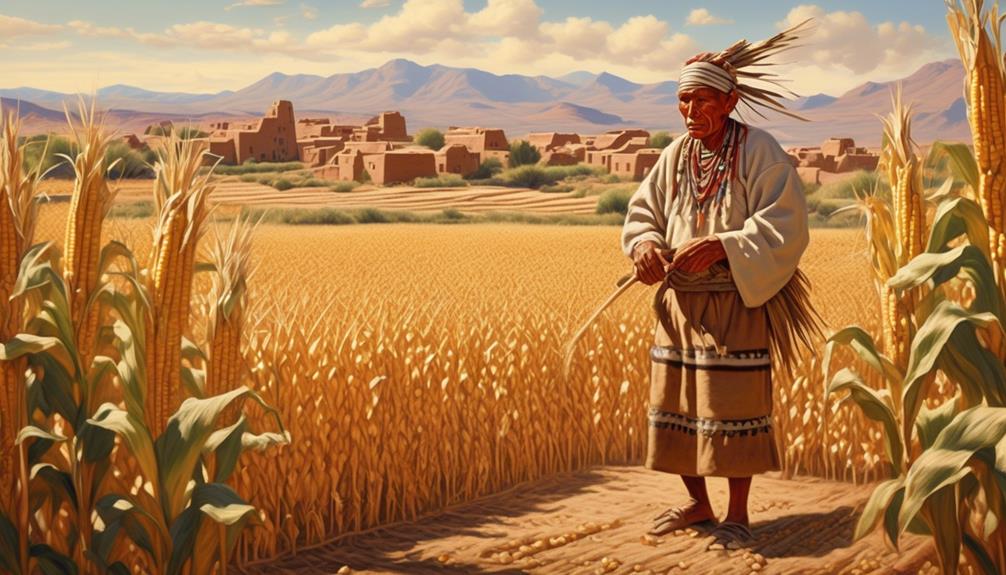
Responsibly tending to the agricultural fields, participating in ceremonial rituals, and contributing to the construction of communal structures are integral aspects of the traditional roles held by men in the Hopi tribe.
- Agricultural Stewardship: Hopi men play a crucial role in agricultural activities, including planting, tending, and harvesting crops such as corn, beans, and squash. They're responsible for ensuring the fertility and productivity of the land, often using traditional farming techniques passed down through generations.
- Ceremonial Participation: Men in the Hopi tribe actively engage in ceremonial rituals that hold deep cultural significance. These rituals are essential for maintaining the tribe's spiritual and social harmony, and men are central to their performance, often taking on leadership roles within these ceremonies.
- Community Construction: Contributing to the construction and maintenance of communal structures is another significant responsibility of Hopi men. From building traditional adobe houses to crafting kivas (underground ceremonial chambers), men are tasked with preserving and perpetuating the tribe's architectural heritage.
Hopi men's tribal responsibilities reflect the gender dynamics and cultural significance within the tribe, emphasizing the interconnectedness of their roles with the tribe's sustenance, spirituality, and communal well-being.
Women's Contributions to Hopi Community
Playing a vital role in the preservation of cultural traditions, the women of the Hopi tribe contribute to the community through their involvement in various essential activities and practices.
Women's empowerment within the Hopi community stems from their active participation in agricultural work, pottery-making, and the practice of traditional crafts. The women are entrusted with the responsibility of cultivating and harvesting crops, which are essential for the sustenance of the entire community.
Their expertise in pottery-making not only provides utilitarian items for daily life but also plays a significant role in preserving the tribe's cultural heritage. Furthermore, women actively engage in the creation of intricate baskets and textiles, showcasing their artistic skills and contributing to the cultural identity of the Hopi tribe.
In addition to their roles in traditional practices, women are also actively engaged in community leadership and decision-making processes. Their voices are valued in discussions related to social and economic matters, demonstrating their significant influence in the community.
Furthermore, women play a crucial role in passing down cultural knowledge and traditions to the younger generations, ensuring the continuity of the Hopi heritage. Through their multifaceted contributions, the women of the Hopi tribe play an indispensable part in the preservation and advancement of their community.
Gender Roles in Hopi Ceremonies
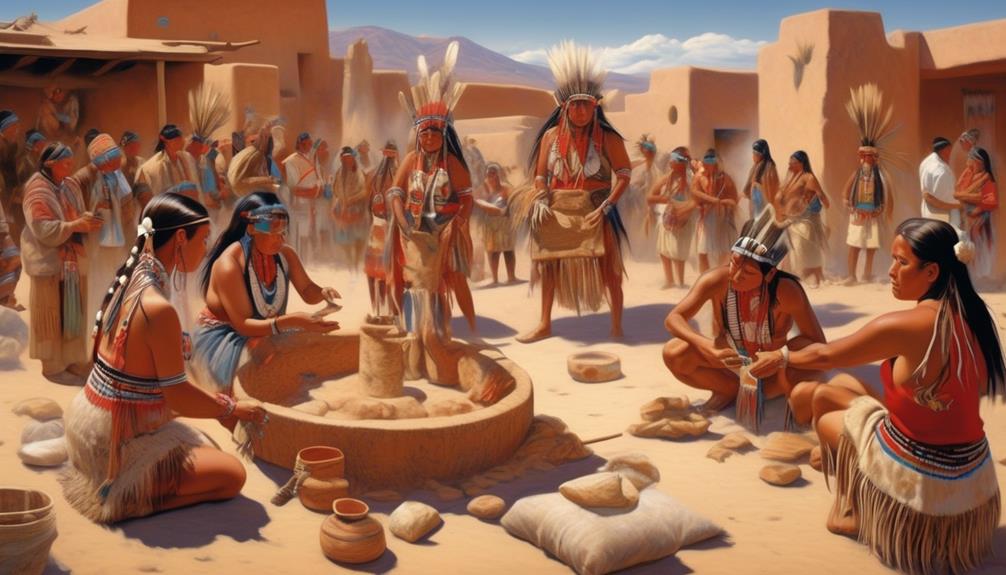
The significant role of women in traditional practices extends to their involvement in Hopi ceremonies, where gender roles play a crucial part in the ceremonial proceedings.
- Gender Dynamics: Hopi ceremonies often have specific gender-based responsibilities. While men may lead certain ceremonies, women also hold essential roles, such as preparing ritual items, creating ceremonial garments, and performing ceremonial dances. These gender dynamics reflect a balance of contributions from both men and women, emphasizing the interconnectedness of their roles in upholding the ceremonial traditions.
- Ceremonial Participation: Women's participation in ceremonies is integral to the overall success and spiritual significance of the events. Their involvement ranges from singing traditional songs to embodying ancestral spirits through dance. This active participation showcases the essential role that women play in preserving and perpetuating the cultural and spiritual heritage of the Hopi Tribe.
- Cultural Preservation: The gender roles within Hopi ceremonies serve as a means of cultural preservation, ensuring that traditional practices are passed down through generations. By actively engaging in ceremonial activities, women contribute to the continuity of ancestral customs and the maintenance of the tribe's cultural identity.
Impact of Gender Roles on Hopi Culture
Gender roles within the Hopi culture significantly influence various aspects of societal practices, including ceremonial traditions and community dynamics.
The Hopi community places distinct gender expectations on men and women, which deeply shape their roles in the society. Men are primarily responsible for agricultural activities, crafting, and participating in certain ceremonies, while women are traditionally in charge of maintaining the household, preparing food, and creating intricate artwork.
These gender expectations have a profound cultural influence, as they dictate the division of labor and the distribution of responsibilities within the community. The impact of these gender roles can be observed in the intricate ceremonies and rituals that are essential to the Hopi culture. Men and women play distinct roles in these ceremonies, reflecting the traditional gender expectations within the community.
Furthermore, the cultural influence of gender roles extends to the social dynamics within the Hopi tribe, shaping interactions and relationships between individuals.
Frequently Asked Questions
How Have Modern Influences Affected the Traditional Gender Roles in the Hopi Tribe?
Modern influences have posed challenges to traditional gender roles in the Hopi tribe. Adaptation to these influences has shifted the dynamics of gender roles.
The impact of modernization on the traditional roles of men and women has been significant. The changes in societal norms and expectations have led to a reevaluation of gender roles within the tribe.
These shifts reflect the ongoing evolution of the Hopi culture and its response to external influences.
What Are the Specific Rituals and Ceremonies That Women Are Responsible for in Hopi Culture?
In Hopi culture, women's ceremonies hold immense cultural significance. These rituals are deeply rooted in tradition and are essential for maintaining the spiritual balance within the community.
The women are responsible for carrying out these ceremonies with precision and devotion, ensuring the continuity of customs passed down through generations. Their dedication to these rituals is a testament to the vital role that women play in preserving the rich cultural heritage of the Hopi tribe.
Are There Any Examples of Individuals in the Hopi Tribe Challenging Traditional Gender Roles?
Challenging traditions within the Hopi Tribe has been observed, reflecting modern influences and generational adaptation. Instances of individuals challenging traditional gender roles have emerged, indicating a shift towards gender equality.
This trend is noteworthy when considering ceremonial responsibilities and cross-tribal comparisons. The Hopi Tribe's ability to adapt and evolve in the face of changing societal dynamics demonstrates a willingness to reconsider and redefine traditional gender roles.
How Do the Roles of Men and Women in the Hopi Tribe Differ From Other Native American Tribes?
Gender dynamics within the Hopi Tribe were unique compared to other Native American tribes. Men and women both held significant roles in the community, with each contributing to the overall societal structure.
In contrast to some other tribes, Hopi women had a prominent role in agriculture, while men were responsible for ceremonial and spiritual leadership.
These cultural comparisons highlight the diversity of gender roles and the importance of understanding specific tribal traditions.
What Are Some of the Ways That Younger Generations Are Preserving and Adapting Traditional Gender Roles in Modern Hopi Society?
In modern Hopi society, preserving traditions and making modern adaptations allows younger generations to maintain the rich cultural heritage of traditional gender roles.
This is evident in the continuation of ceremonial practices and the incorporation of traditional teachings into contemporary life.
The community actively engages in passing down knowledge and skills to ensure the endurance of these roles.
This blend of tradition and adaptation fosters a deep connection to our heritage while embracing the evolving world.
Conclusion
In conclusion, the intricate web of traditional gender roles in the Hopi tribe is like the delicate threads of a reed basket, each part essential to the strength and beauty of the whole.
Men and women play distinct but equally important roles in the community, contributing to the rich tapestry of Hopi culture.
Their harmonious balance reflects the interconnectedness of all living things in the natural world, a vital aspect of Hopi identity and heritage.
Mary is a passionate writer who brings creativity and a fresh perspective to our team. Her words have the power to captivate and inspire, making her an essential contributor to our content. Mary’s commitment to storytelling and dedication to promoting Indigenous culture ensures that her work touches the hearts of our readers. We’re fortunate to have her as part of our team.
